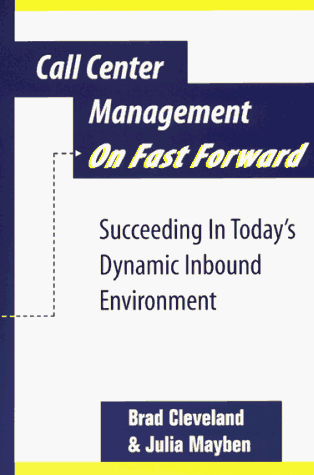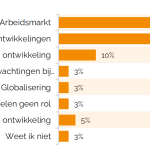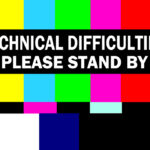Strong price pressure in outsourcing and nearshoring, continued automation and more attention to EX and CX: the world of customer contact now seems quite homogeneous. There is one difference: in the US, outsourcing and nearshoring are part of ongoing public debates, according to Brad Cleveland.

First edition (1999)
Brad Cleveland, co-founder of the renowned ICMI (in which he is now only involved as an external advisor), travels the world for keynotes and workshops. He also carries out consultancy projects for various global clients. In the meantime, he is working on the next editions of the books Leading the Customer Experience and Contact Center Management on Fast Forward. The latter book was first published in 1999 and last in 2019 (fourth edition).
As far as he is concerned, enough has changed in the field to work on new updates of both titles. “Many organizations are embracing AI and automation more than ever, using chatbots and self-service portals to respond faster so employees can focus on more complex interactions. In addition, we are really looking for opportunities to provide personalized service. This is all about understanding the needs of customers and creating experiences and solutions that suit them exactly. At the same time, attention to employee experience is growing. Companies are investing in tools, training and wellness initiatives that keep staff engaged and productive.”
No guide country
 Thirty years ago, Europeans liked to shop in the US to import the latest call center technology. In terms of technology, the US is again a leader thanks to the introduction of generative AI, but as far as Cleveland is concerned, this is different for the US as a guide country for CX or customer contact. “I have had the opportunity to work in more than 60 countries. It is not so much countries but rather specific organizations that are leading the way. There are innovative players everywhere – including in regions that many would consider developing countries, such as Eastern Europe and South America. Great things are also happening in Dubai and other parts of the Middle East.”
Thirty years ago, Europeans liked to shop in the US to import the latest call center technology. In terms of technology, the US is again a leader thanks to the introduction of generative AI, but as far as Cleveland is concerned, this is different for the US as a guide country for CX or customer contact. “I have had the opportunity to work in more than 60 countries. It is not so much countries but rather specific organizations that are leading the way. There are innovative players everywhere – including in regions that many would consider developing countries, such as Eastern Europe and South America. Great things are also happening in Dubai and other parts of the Middle East.”
In many places he sees a rapid introduction of new technologies, which, in his opinion, “heralds a new generation of contact centers”.
Labor market: an issue everywhere
In the US, finding and retaining talent is also at the top of the list of challenges for in-house contact centers. But many companies are still busy developing the contact center into an integrated part of the organization where customer experience comes first. What in-house and facility contact centers in the US have in common is that they are eagerly seeking opportunities to provide more personalized services while simultaneously solving data security and privacy concerns, Cleveland said.
Public debate?
In addition, the facilities feel the pressure for competitive prices while maintaining the quality of service. The latter, together with the consequences for employment, is a subject public debate and that is different from in the Netherlands, where that debate is hardly conducted publicly.
“While it is seen as a strategic move by companies to cut costs and focus on core competencies, there are also concerns about loss of jobs en loss of quality. Within the US, similar discussions are taking place between states and regions. These types of discussions will always continue, especially in a global economy, where technology has helped bridge distances in space, language and time.”
“Outsourcing is not always 'all or nothing'”
The CX movement is booming in the Netherlands. At the same time, waiting times are increasing and service seems to be becoming a scarce commodity. Digitalization is advancing, the labor market is tight and more and more companies are opting for this outsourcing to Suriname (low costs, Dutch). That pattern is recognizable for Cleveland. “Here too, customer experience (CX) is in the spotlight as wait times increase and some organizations outsource to regions with lower labor costs. However, I also see a trend among many leading organizations to keep contact center services in-house.”
He emphasizes that outsourcing is not always an 'all or nothing' issue: “You can also get help with certain channels or certain types of interactions.”
Impact of generative AI? wait
Will generative AI lead to more or fewer people in the front office? Cleveland: “Many opinion leaders expect that the further development of generative AI will result in a front office with less human intervention. I'm not so sure. 30 years ago, many predicted that the Internet itself and the extensive services it brought would reduce the need for agents. What is repeatedly missing from those predictions are the new interactions and new industries that come along with all these innovations. I guess we'll have to wait and see.” And of course, he advises, it is best to maintain a customer contact strategy in the meantime that uses technology and continues to get the best out of your people.
“Our sector is in a transformation process due to rapid technological developments. It remains a fascinating period for customer experience, customer service and contact centers.”
About Brad Cleveland Brad Cleveland worked with clients such as American Express, Apple, USAA and the University of California, as well as with non-profits and governments at the federal and state levels. He has published extensively on customer contact; in addition to ten books, and articles regularly appeared in media ranging from The Wall Street Journal to The New York Times. He was one of the founders of ICMI.
(Ziptone/Erik Bouwer)
Customer Experience, Featured


